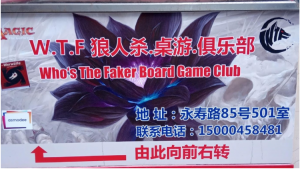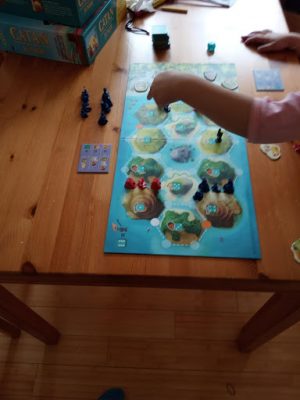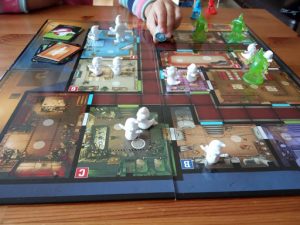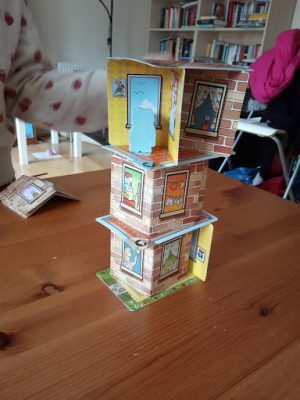Early in the summer of 2019, I was lucky enough to be in Shanghai for work. The weather wasn’t yet too hot and it was nice to walk around. My hotel was downtown, only one metro stop from People’s Square, in a neighborhood that mixed fairly old residential buildings with larger commercial skyscrapers. Near my hotel, I spotted a sign for a games café, hidden away on the fifth floor of a nearby building. For one reason and another, I didn’t manage to visit (and even if I had, I doubt my Chinese would have been good enough to play with other people in there).

This wasn’t the first games café I’ve seen in China. Not far from where I was staying, there was the Baimu Hobby Mall, which has been around for well over a decade and which seems increasingly out of place in modernizing, gentrifying downtown Shanghai. The mall is no longer so focused on gaming and toys, but, on my last visit, there was still a well-stocked games café there and at least one shop selling modern board games, often translated into Chinese. The Chinese localized versions were cheaper than their English counterparts, which I assume were imported and, like most imported goods in China, sold at higher prices to emphasize the prestige value of buying them.
The presence of games cafés and board game shops in Shanghai shouldn’t come as a surprise – after all, it’s a mega-city of over 25 million inhabitants and some of them, one would imagine, like playing board games. Yet it also feels slightly out of place: the hobby of board gaming is associated with Western European and American games, companies and practices. Games are regularly referred to as Eurogames (for often abstract, non-aggressive interaction type games) or Ameritrash (for lots of dice rolling and more aggressive player interaction). And, in fact, a lot of the games I saw in Shanghai were the same games I would recognize from game shops in the UK (where I live): classics like Catan, Carcassonne, Power Grid, as well as more recent games. Some of these are translated from German, while other games are produced in English, and others in French or a number of other languages and translated into English, or in the case of some of the games I saw in Shanghai, into Chinese. Game production is in fact, spread throughout the world, as the regular column “Around the World in 80 Plays” in the British magazine Tabletop Gaming reminds readers by focusing on games coming from different countries each month.
Board games, as well as RPGs and other forms of analog games, circulate in translation in different languages and locations. Like many other forms of cultural production, they rely on translation. People can play games in more than one language, of course, and non-translated texts do circulate – think of people writing about finding new games at Essen, for instance, or the presence of untranslated games on shop shelves (which is probably more common outside of Anglophone countries, though still happens to some extent in English-speaking ones). However, the translation of tabletop games has received very little attention academically, from either games studies or translation studies (as I shall discuss later).
In this article, I aim to address this gap by highlighting the importance of translation to board and tabletop games as well as gaming culture more generally. Translation, as I shall show, is intergenerational: it offers an introduction to a game or text to a new audience. At the same time, it highlights the fact that games are experienced in multiple variants. Indeed, as my examples from Shanghai show, gaming culture institutions like game cafes are themselves translated to different locales and there are local variations on the theme too: drinks menus, games stocked, the presence (or absence) of food are all subject to cultural adaptation. This translation of both textual material and cultural practices needs to be understood in a context of globalization of culture and the power relations that that entails: the presence of translated German and American games in Shanghai shops demonstrates the relative prestige of those gaming cultures and producers, as well as hinting at the economic power of their publishers in terms of international distribution. It seems necessary, then, to focus on translation not just in a linguistic sense, but also in a material sense and as part of the global flows of culture.
Translation and analog games
Before discussing the ways in which an understanding of translation can deepen conceptualizations of games and gaming, it’s necessary to review what translation means and the work on games from translation studies and localization practice. Sometimes, discussions of translation can be overwhelmed by discussion of errors or of quality, which does not allow for the more complex (and interesting!) discussions of the relationships between translation practices and global copyright, or how translation can influence cultural development. There is also a risk of reducing translation to “interlingual translation”, which Roman Jakobson famously also called “translation proper”, in other words, translation between languages. Yet, while Jakobson regarded the translation of texts from one language to another as “translation proper,” he also allowed for two other types of translation in the same essay: translation within a language (“intralingual translation”) and between media (“intersemiotic translation”). These two possibilities are quite common in tabletop games: there are children’s versions of classic games, such as Catan Junior, which is an intralingual translation of the game Catan for a younger audience, and there are games that develop from narratives in other media, such as Tails of Equestria, which could be considered an intersemiotic translation of the cartoon My Little Pony: Friendship is Magic into RPG form. These forms of translation are often closer to what is understood as adaptation, but translation could also be considered a subset of adaptation, as it is by Linda Hutcheon.

Translation could be considered any form of rewriting a text for a different audience, which would include all of the variations mentioned by Jakobson as it would allow for interlingual, intralingual and intermedial rewritings of a text. Many of these rewritings are across languages, but keeping in mind other possible types of rewriting increases the understanding that translation is about reformulation, which involves making decisions and interpreting the text, rather than just reproducing it. This introduction of a text for a new audience is a form of intergenerational contact, especially as in games, as I shall show, the translations of texts are often made by people with a greater understanding of the rules for people with less knowledge or understanding of them.
In translation theory, the notion of “rewriting” was put forward by André Lefevere to refer to a series of textual practices, including interlingual translation but also including anthologisation, historiography and criticism, that adapted a text for different audiences. My discussion of translation as a form of rewriting is indebted to Lefevere’s work, but where he focuses on literary rewritings, I include forms of transmedia adaptation and other media forms. In which case, translation can be considered not as just an interlingual practice but also an intermedial practice.
Focusing on how texts are adapted and translated for different audiences means questioning not only the textual differences but the reasons why such differences come up. Lefevere offers the useful notions of “poetics” and “patronage” to help explain why translated texts differ. “Poetics” refers to the expectations in terms of form that the target audience has of a translated text. So, for example, texts are adapted in translation to fit target audiences’ expectations of a text, for example the shape of a sonnet or the way in a prose narrative might develop. That said, this is not a very fixed system and translated texts can alter and expand poetics, so that imported forms become popular and translated texts are no longer altered so much and local production starts to use those same forms. Arguably, in terms of board games, with the success of Catan and other 1990s and early 2000s “Eurogames” from Germany, then the “poetics” of English-language boardgaming was altered as expectations of how games can work have changed and what used to be considered a German style of board gaming has now become quite common in English-speaking countries.
“Patronage”, Lefevere’s other term, refers to who is paying for the translation and what they want it to do. This might mean translating for different publishing houses, or on government grants. “Patronage” can be transferred quite easily to tabletops: a commercial publisher may want quite a different translation of a game to a smaller publisher. The game Ghostbusters: Protect the Barrier, published by Mattel, offers an example of the effects of patronage. It is a rewriting of the Kinderspiel des Jahres [Children’s Game of the Year] winning Geister, Geister, Schatzsuchmeister! [Ghost Fightin’ Treasure Hunters]. Here there are at least two types of translation: of the game Ghost Fightin’ Treasure Hunters, which has been translated into German (as the creator Brian Yu is American), which is the language it was first published in, and then a translation for another audience, using the Ghostbuster’s licence, that aims at a more casual gaming audience. The price of Protect the Barrier was lower and the theme (Ghostbusters recovering devices) was more prominent as a movie tie-in. A smaller publisher might not be able to publish a game as a movie tie-in or in a different version for casual gamers. Nor might a smaller company launch a game in translation first, especially if the company itself is based in the USA. Mattel’s patronage, therefore, allowed these translations to take place and influenced the sorts of translation, taking place across languages and for different audiences. Patronage also returns us to the question of the power of publishers and distributors, as seen by the presence of games like Catan in Shanghai. These texts are translated not only because they are good games, but also because, in the case of Catan, it is published by Asmodée which also own Days of Wonder and Fantasy Flight Games. Patronage highlights that translations are undertaken in relation to commercial (and political) interests, who influence what texts (games in our case) are translated and how that translation is done, in terms of strategies and even business practices.

The little scholarly research there is on analog game translation focuses on the textual elements, mainly the rules and the in-game text. This seems to be due to the necessity of establishing that analog games are a valid area of research for translation (and indeed more generally, as early editorials in this journal demonstrate) by applying frameworks of study that are commonly used in translation studies. Drawing on discussions of style and multimodality, this work is useful for understanding how board games work as text. In this, they parallel the work on video game localization from translation studies, which also focuses in on the practices and challenges for localizers.
Beyond textual translation
But there are more aspects of games to consider in relation to translation. Minako O’Hagan and Carmen Mangiron (pp. 278-311) discuss issues of accessibility and fan cultures for video game translation, both of which remain relevant in board game translation. Board and tabletop gaming culture is an example of a participatory fan culture, where fans are often empowered to be translators (especially for less spoken languages) and where games creators often discuss games with fans (on, for example, the Board Game Geek forums).
Accessibility refers to the adaptation (or, as I argued above, translation) of games for different audience based on those audiences’ different sensorial capacities. An obvious example of accessibility is the availability of subtitles for the Deaf or hard of hearing; the text is made more accessible through allowing Deaf users to access it. The website Meeple Like Us is focused on board game accessibility and reviews ways in which games are accessible to people with visual or cognitive impairments. These include features such as easily distinguishable color usage (as, for example, reds and oranges can easily be mixed up) or designing games to be accessible without recourse to reading. Other aspects of accessibility may be designing spaces to be inclusive and non-threatening, so that players are not traumatized by playing the game (such as by avoiding topics that are distressing, as this report from the BBC about an incident at Games Expo 2019 demonstrates). One adaptation of role playing games that encourages such inclusivity is John Stavropoulos’s X-card, which allows players to stop a game when something is making them uncomfortable. Using the X-card in a game which didn’t originally include it is a form of adaptation of the text in order to make it more inclusive, which allows a different audience to play it. Other adaptations may include changing the meeples used, adapting rules for different groups, reading out materials for players, adapting narratives for different groups, and so on. All of these alterations in translation effectively make texts accessible to new and different audiences.

Accessibility brings us beyond the textual forms of translation that have been typically discussed to other instances of translation in gaming that are somewhat more ephemeral and which take place at the gaming table. Many of the translations are ad hoc translations that are undertaken to fit one specific gaming group. For example, when I play Rhino Hero with my young daughter (a literal case of intergenerationality), I summarise the rules for her in a form of intralingual translation as her reading skills are not yet good enough to read them herself. We also drop the rules related to the symbols that would alter turn order, direction of play and so on, focusing only on the game as a dexterity game where players have to build a tower from the cards and move the rhino. Here I adapt the game to make it more accessible to her, as (at the moment) these rules would make the game too complicated for her to enjoy the game.
While this translation of the rules is accessibility focused, there are also times when games are translated across languages at the table (or playing space). One typical instance would be where not all players can read the language the game is written in. For example: a family in China playing a game with English rules, or an American gaming group playing a German language game that someone has brought back from Essen. Here, at least one player needs to linguistically mediate – translate – the text for the other players to a level that they understand the mechanics of the game. This might involve elements of simplification, or leaving out complex aspects until they are encountered in the game, or in other ways paraphrasing the rule set to allow players to play it. The same process can take place intralingually, too, as one player explains a game to other players who have not read the rules. While this seems different from the sorts of translations I have been discussing above, as it is not written down and is somewhat improvised, in both the interlingual and intralingual cases it is still an action which seeks to translate the materials of the game for a new audience. It therefore can be considered part of the range of “translational actions” discussed by translation theorist Christiane Nord: not necessarily translations in the textual sense, but actions which seek to mediate texts for an audience that cannot access (linguistically or for other reasons) the source.
One of the reasons this sort of translation has not been researched is its ephemerality: there are seldom any records of the changes made. In many ways, it resembles the way in which Michel de Certeau characterizes common approaches to reading: “to receive [a text] from someone else without putting one’s own mark on it.” Yet, de Certeau continues, reading is a far more active activity than this: the reader “invents something different in texts than they ‘intended.’” Playing games resembles this more active reader as the texts themselves are more open than novels, but also because games are commonly adapted and translated in a variety of ways in a play situation to fit the different group (in the sense of the people around the table or playing space) that are playing. While this tends not to be recorded by most groups, it could be if an ethnographic approach to analog gaming was used, by, for example, observing public games at conferences.
Translation, variation and global culture
I have stressed the formal and informal, or textual and ad hoc, senses of translation in relation to board games in order to demonstrate the complexity of the ways in which games are translated and adapted. Translation is a significant part of the playing of board games, both in the spread of the games themselves and also in the ways in which games are tweaked, altered and adapted in a play situation to make them accessible to players. It’s this accessibility that translation represents: being able to access a game that was originally written in another language or being able to play a game that has been altered in order to fit the playing group. As I’ve argued, there is an intergenerational aspect to this as the person undertaking the translation uses their knowledge of the game or rules system in order to make it accessible to other players who are not so familiar with it.
These variations in game play bring about a question of the ontology of games: how far can one alter a game before it becomes a different game? Is my simplified way of playing Rhino Hero, for instance, a different game to the published version? Is Catan a different game to Die Sedler von Catan [the original German version]? The answer to me appears to be a bit of both “yes” and “no.” C. Thi Nguyen argues that games have a “prescriptive ontology”: in other words, you encounter games as a game and the social understanding of what a game is means that you play by the rules of the game, rather than, for example, playing Catan by throwing its hexes across the room. While this example might be one way of playing with the Catan material, it’s not how you play the game Catan, which looks in many ways like the German language version of the game. A translated game still offers very similar rules and very similar gameplay experience, bearing in mind that games are experienced differently when playing with different players and different situations. And yet alterations to a game do change the playing experience, too, so that the game is ever so slightly different when translated across languages or for different groups.
However, some games also come with variations as part of the rules, suggesting that there is often more than one legitimate way of playing a game. For example, in Ghostbusters: Protect the Barrier players can choose four different variations of the game play, which involve slightly different possibilities as the game develops. One version is “Basic Battle”, which is the default way to play and where player characters can collect the paranormal energy devices in any order. “Advanced adventure,” on the other hand, includes extra cards, doors that shut, and the energy devices need to be collected in order. The playing experience of these two versions is quite different, with one requiring more strategic planning than the other and different degrees of tension. Yet they are the same game, even though they are different. This feels paradoxical unless we accept that games themselves are understood in a way that allows for variations in them: we accept that each game can have multiple variations, both formal and informal, while not turning into a different game. When a game is significantly, as for example the relation of Catan Junior to Catan, then it does become a different game but with an intertextual link to the original game. Wittgenstein argued that games are a “blurred concept,” as the concept of games includes many possible variations. Individual games, too, have a sort of blurry ontology that recognizes them as being the same game even when played in different ways (variants, versions, languages).
A short example can demonstrate here the way in which a game can be altered and still be understood as the same game. Little Wizards is a translation of the game Contes Ensorcelés, written by Antoine Bauza, who is well known as a game designer, notably for Seven Wonders. The French game was originally published as two separate volumes, whereas the English translation uses only one volume. Two translators are named, Franck Florentin and Amanda Valentine, but Valentine is also credited with development of the game. Already, these paratextual features suggest that the game itself has been altered from the French original. Furthermore, the blurb on the back of the book mentions “updated rules and game content,” again highlighting the differences from the French game. In an interview with Apathy Blog, Valentine mentions the many changes, ranging from the addition of advice for the “narrator” (the gamesmaster of the system), to addition of material in one of the adventures, and general “streamlining” of the rules. This goes beyond the usual role of the translator understood as solely someone who mediates linguistic content, yet fits the idea of the translator of someone who adapts a text to a different audience that I discussed earlier. As such, although there are differences in the content of the book and how it is presented, as well as the fact that it is in a different language, Little Wizards is still a translation of Contes Ensorcelés and anyone familiar with one would be able to play the other with little difficulty, recognizing it as the same game.
This acceptance of variation brings us back to the question of games as part of global culture, due to the variation of games as they are translated and distributed around the globe. Games are played in different languages and versions, with various adaptations for each game group. Yet they are recognizably the same games. This sort of variation of how games get played suggests that, rather than saying there is a thriving global gaming culture, it would be more precise to say that there are multiple thriving gaming cultures that are spread across the globe. These gaming cultures may approach games slightly differently or have different preferences in which games to play. Some have more power and visibility than others: the English-language gaming culture seems more obviously visible, due to the use of English on websites like Board Game Geek and the influence of blogs and shows like The Dice Tower. Similarly, the German-language gaming culture shows its influence through global importance of the Spiel des Jahres [Game of the Year] awards. Such awards affect what games get translated and distributed in other countries as they function as a marker of prestige (and to some extent affect the market value of a game).
To conclude, I’ve been arguing that discussing games without reference to translation risks ignoring the multiple, complex relationships between gaming production in different countries and the way in which games circulate, which is influenced by forms of prestige and visibility, some of which are affected by the patronage of major international games companies. If we look at analog gaming – and I have focused on board and role playing games here but the same issues can be discussed in relation to card games, live action roleplaying (LARP) and other forms of analog games – as a global activity, we see that it is always and everywhere mediated by forms of translation. Analysing these forms in more depth, in case studies or theoretical work, reveals the complexity of games as cultural texts, especially due to what I’ve called their blurry ontology, as well as their relation to gaming cultures and practices in different locations.
Importantly, I’ve argued that translation is a form of rewriting for different audiences and therefore is an intergenerational practice. However, I do not mean intergenerational in the literal sense of from parent to child – though this is indeed a possibility as parents do translate games for their children (as I discussed in relation to Rhino Hero). Rather, by intergenerational I have meant that people with knowledge of a game or gaming system that others do not have translate the game or system in such a way that the game or system becomes accessible to the people without knowledge of it. While this formulation is somewhat clunky, it allows openness as to what translation can be: it can be across languages, it can be a formal process, or it can be intralingual and informal, as the various examples of translation that I’ve discussed in the article demonstrate.
Translation is, therefore, a way of spreading texts and cultural practices. In a very concrete sense, translation introduces games (and other texts) to new audiences. In terms of games and the gaming hobby, the hobby of gaming is spread through acts of translation at the interpersonal level – “hey! Have you played Carcassonne? No? I’ll explain it” – and on the level of translation of game rules for games publishers for different linguistic markets. While it’s true that individuals can teach themselves game rules, and some can read games in more than one language, in practice game playing will involve some mediation of those rules to others in order to be able to play as a group. And, as I’ve written, it is also common for gaming groups (both formal and informal) to have various forms of house rules that translate and adapt the game for their specific needs or preferences. Such possible variability in games means that they can be introduced to many different players and are, potentially, a democratic form of culture. Yet if they are introduced to different players with different needs, then problematic aspects, such as the orientalist imagery of many European games, or the lack of representation of disabled characters or the LGBT+ community in board and role playing games, will need to be rethought to make games more inclusive and accessible to their new audiences. Thinking about the translation of games reveals, then, the way in which games and gaming cultures are spread, and highlights the importance of such spreading to inclusivity in game design.
–
Featured image “Reflecting on Words” is by Julie Jablonski @Flickr CC BY-NC 2.0.
–
Jonathan Evans is Senior Lecturer in Translation Studies at the University of Portsmouth, UK. He is the author of The Many Voices of Lydia Davis (2016) and co-edited The Routledge Handbook of Translation and Politics (2018). His research interests focus on the global circulation of film and non-hegemonic ideas. He is CoI on the Arts and Humanities Research Council (UK) funded project ‘Translating for Change: Anglophone Queer Cinema and the Chinese LGBT+ movement’.

